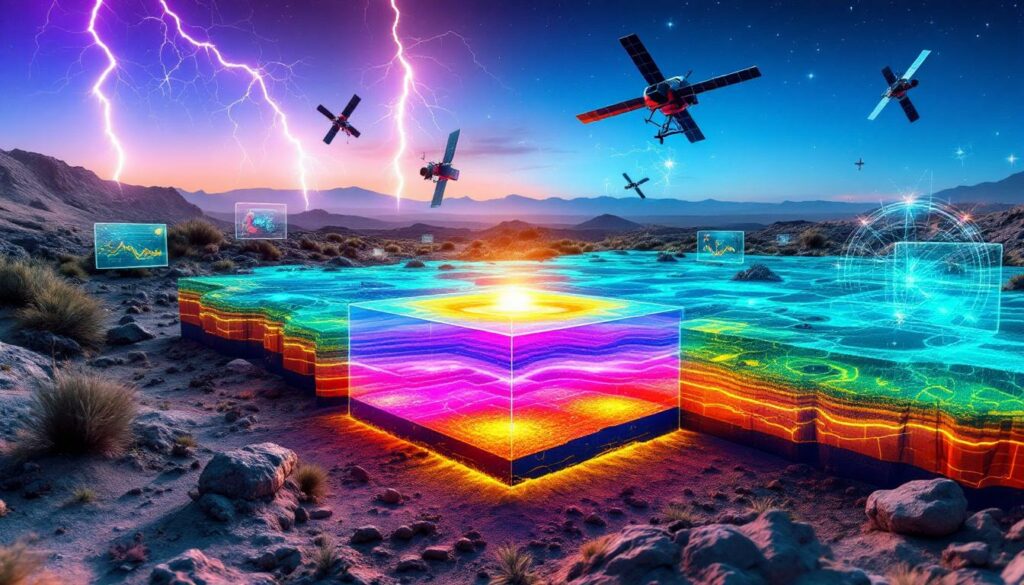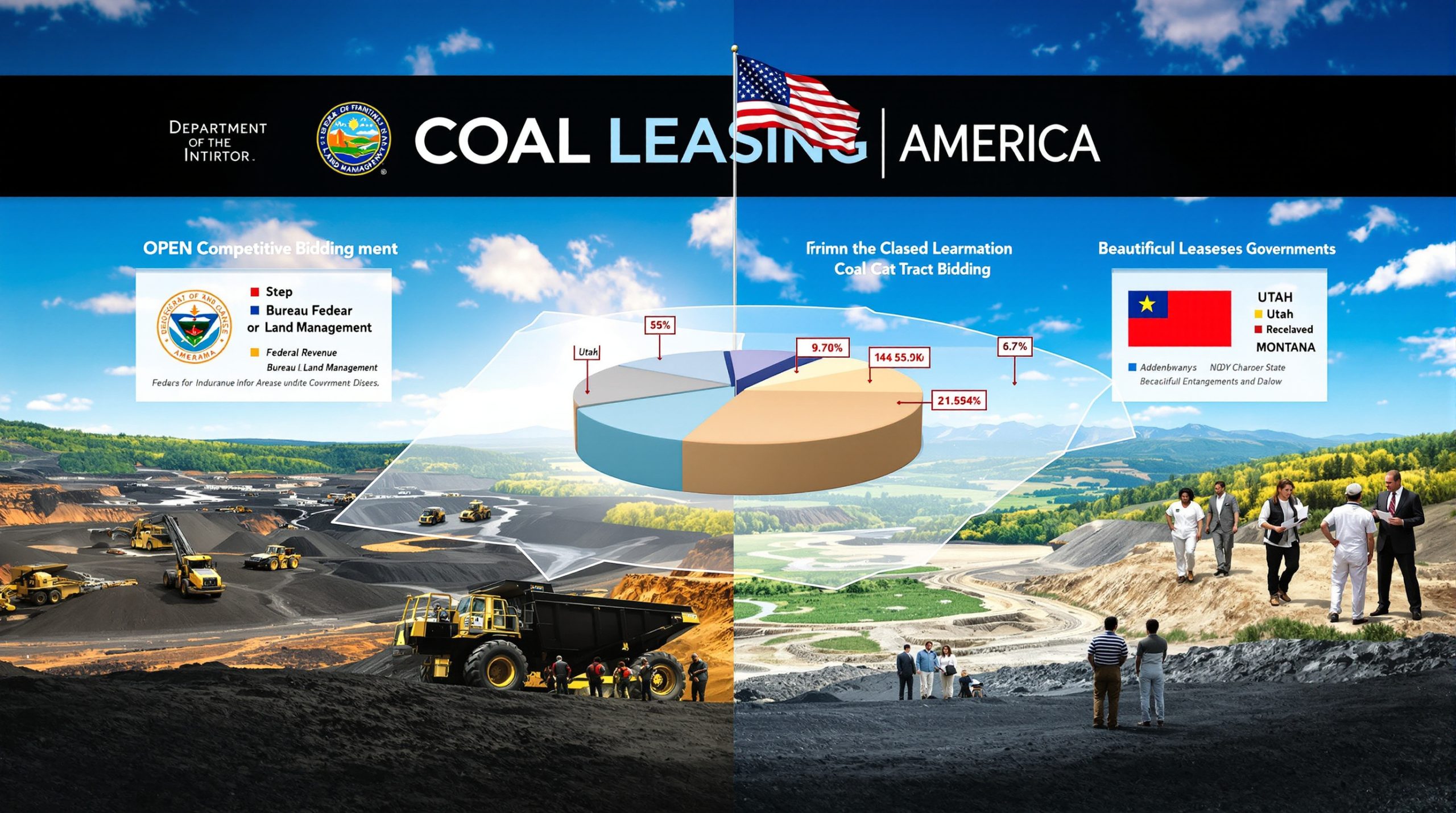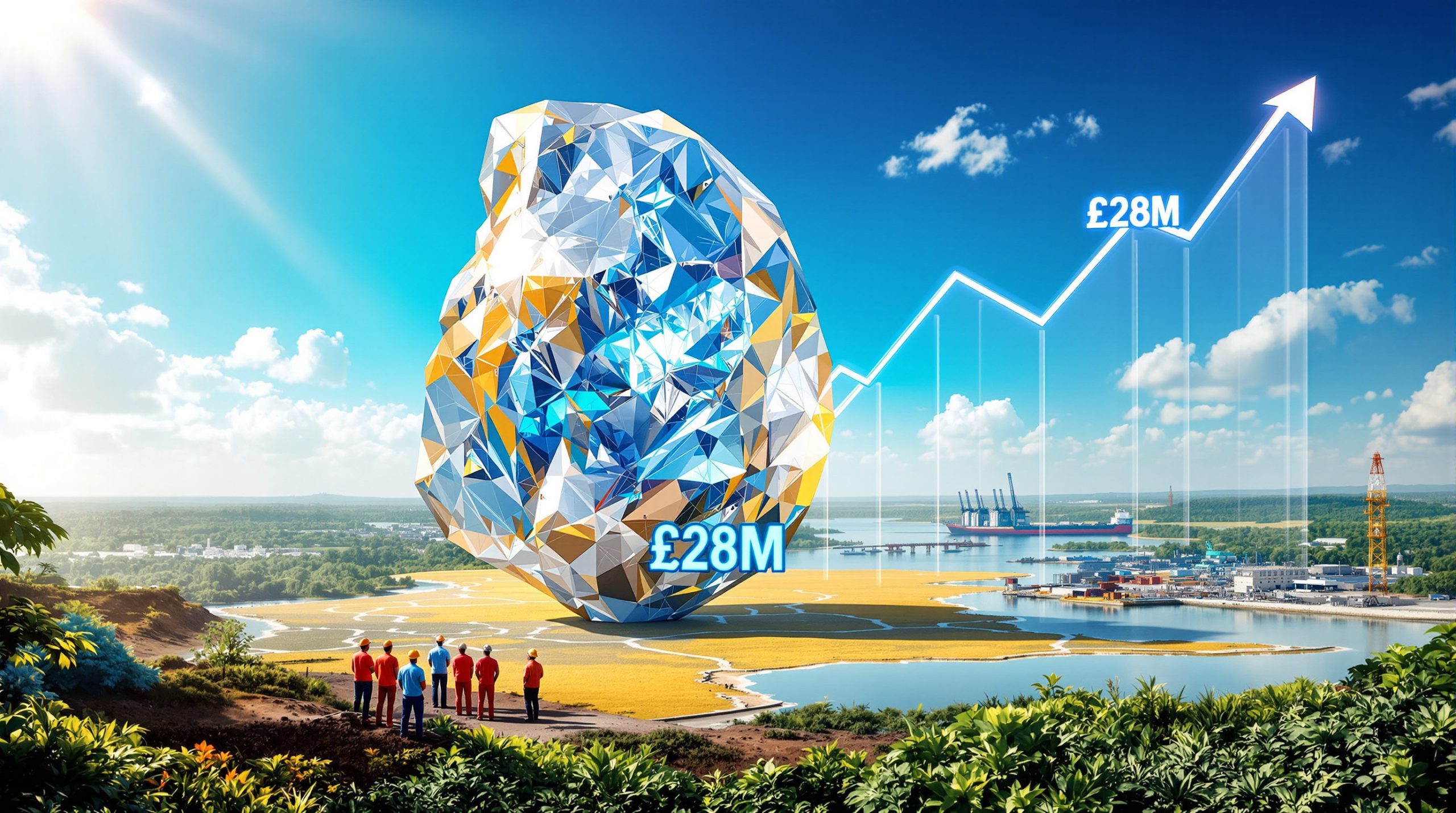Understanding Magnetotellurics in Mineral Exploration
Magnetotellurics (MT) represents a sophisticated passive geophysical method that harnesses naturally occurring variations in the Earth's electromagnetic fields to reveal what lies beneath the surface. Unlike active geophysical techniques that require artificial signal generation, MT leverages electromagnetic phenomena produced by solar winds and thunderstorms to measure the electrical resistivity and conductivity of subsurface materials.
"MT is uniquely suited to image crustal structures, fluid pathways, and alteration zones—critical features for enhancing orebody knowledge in mineral exploration programs," explains Dr. Hemant Chaurasia, CTO of Fleet Space Technologies. This distinctive capability makes real time magnetotellurics in mineral exploration particularly valuable for detecting conductive minerals such as sulfides, which are primary exploration targets for copper and other valuable commodities.
The technology excels at providing comprehensive subsurface imaging at depths ranging from near-surface to several kilometers below, offering exploration teams insights into geological structures that might otherwise remain hidden from traditional sensing methods.
Science Behind MT Technology
MT measures natural variations in Earth's electromagnetic fields by deploying sensitive magnetometers and electrodes in strategic configurations. These instruments detect tiny fluctuations in electrical and magnetic fields, which vary based on the conductivity of subsurface materials they pass through.
What makes MT particularly valuable is its passive nature—there's no need to generate artificial signals, reducing both operational complexity and environmental impact. The technique works by measuring how electromagnetic waves interact with subsurface materials, providing detailed information about resistivity structures that can indicate mineral deposit tiers and geological boundaries.
How MT Differs from Other Geophysical Methods
Unlike seismic methods that measure acoustic wave propagation or gravity surveys that detect density variations, MT focuses specifically on electrical conductivity contrasts in the subsurface. This specialization makes it exceptionally effective at identifying conductive bodies such as sulfide deposits—often associated with valuable copper, nickel, and other mineral resources.
MT also offers exceptional depth penetration compared to many other electromagnetic methods, with the ability to image structures from near-surface to depths exceeding 10 kilometers depending on survey configuration and local conditions.
Perhaps most importantly, MT provides complementary information to other geophysical techniques, making it an essential component in multiphysics exploration approaches that combine different data types to build comprehensive 3D geological modelling systems.
Why Has Real-Time MT Been a Game-Changer?
Despite its effectiveness, MT has historically faced significant adoption barriers in the mining industry. Traditional surveys required labor-intensive setup procedures, complex logistics management, and lengthy data processing times—often taking weeks or months to deliver actionable insights. These limitations restricted MT's widespread deployment, particularly for time-sensitive exploration campaigns.
"Historically, MT's value has been constrained by slow deployments, complex logistics, and delayed results," notes Dr. Chaurasia. "But with ExoSphere MT, we're combining advanced sensors, edge processing, satellite integration, and rapid cloud-based data processing to transform MT into a dynamic tool that delivers actionable 3D insights within days to exploration teams in the field."
This transformation from months-long processing to results in days represents a fundamental shift in how real time magnetotellurics in mineral exploration can be deployed, particularly in remote or challenging environments.
Historical Limitations of Traditional MT Surveys
Traditional MT surveys faced several significant challenges that limited their application in mineral exploration:
- Labor-intensive deployment: Conventional systems required complex electrode arrays and extensive field preparation.
- Data transmission bottlenecks: Limited bandwidth made transferring large volumes of raw MT data challenging.
- Processing delays: Complex processing algorithms often took weeks or months to generate interpretable results.
- Expertise requirements: Specialized knowledge was needed both for field operations and data interpretation.
These limitations often made MT a secondary choice for exploration teams, despite its valuable insights into subsurface conductivity structures.
Technological Breakthroughs Enabling Real-Time Processing
Recent technological advancements have transformed MT into a real-time exploration tool. These innovations include:
- Edge computing capabilities: On-device pre-processing now allows for initial data analysis directly on field devices, dramatically reducing data transmission requirements.
- Satellite connectivity: Real-time data transmission enables continuous monitoring of system health and performance.
- Cloud-based processing systems: Advanced algorithms have dramatically reduced analysis times, delivering 3D resistivity models in days rather than weeks or months.
- AI-compatible data formats: Standardized outputs enable integration with machine learning platforms for enhanced interpretation.
These technological breakthroughs have collectively addressed the historical limitations of MT, making it a viable real-time tool for modern data-driven mining operations.
How Does ExoSphere MT Transform Mineral Exploration?
Fleet Space's ExoSphere MT platform represents a significant advancement in magnetotellurics technology. Following a successful US$100 million Series D funding round, the company has expanded its vertically integrated exploration capabilities, offering a comprehensive solution that addresses many traditional limitations of MT surveys.
"At Fleet Space, we're building the next generation of space-enabled exploration technologies for a new data-driven paradigm in mineral discovery," explains Flavia Tata Nardini, CEO of Fleet Space Technologies. "ExoSphere MT is a crucial component of our broader vision to help exploration teams make faster, more informed decisions through real-time data integration."
Key Features of the ExoSphere MT Platform
The ExoSphere MT platform includes several innovative features designed to streamline the MT workflow:
- Satellite-enabled devices: Real-time data acquisition and transmission from even the most remote exploration sites.
- Edge processing capabilities: On-device pre-processing that streamlines data transmission and reduces bandwidth requirements.
- Live telemetry monitoring: Continuous monitoring of system health and performance to maximize uptime.
- Rapid quality control processes: Delivers phase tensor, resistivity, and penetration depth maps in days rather than weeks.
- Cloud-based inversion: Generates detailed 3D resistivity models through sophisticated processing algorithms.
These features collectively transform the MT workflow, dramatically reducing the time between data acquisition and actionable insights.
Integration with Multiphysics Exploration Approaches
One of ExoSphere MT's most valuable capabilities is its seamless integration with other geophysical methods. The platform allows for parallel deployment with seismic and gravity surveys, creating a comprehensive multiphysics approach to exploration.
In March 2025, Fleet Space acquired HiSeis, an industry leader in active seismic solutions, further enhancing its multiphysics exploration offerings. This integration enables:
- Cross-validation of findings: Different geophysical methods can confirm and refine target identification.
- Reduced uncertainty: Complementary data types help resolve ambiguities in geological interpretation.
- Comprehensive 3D visualization: Combined datasets create more complete subsurface models.
- Enhanced target prioritization: Multiple lines of evidence strengthen confidence in exploration targets.
This integrated approach delivers a more complete three-dimensional view of subsurface structures, enabling exploration teams to make more informed decisions about target prioritization and follow-up investigations.
What Are the Technical Advantages of Real-Time MT?
The technical advantages of real-time MT extend beyond simply accelerated timelines. The technology offers fundamental improvements in data quality, operational efficiency, and integration capabilities that collectively transform how exploration teams approach subsurface imaging.
Edge Processing and Satellite Connectivity Benefits
ExoSphere MT leverages edge processing to perform initial data analysis directly on field devices. This approach eliminates a critical bottleneck in traditional MT workflows by reducing the volume of raw data that must be transmitted. Specific benefits include:
- Reduced data transmission requirements: Pre-processing filters out noise and compresses data before transmission.
- Continuous operational monitoring: Satellite connectivity enables real-time system health checks.
- Remote configuration adjustments: Survey parameters can be modified remotely based on initial data quality.
- Optimized power management: Edge processing allows for more efficient use of battery power in remote deployments.
These technical advantages make ExoSphere MT particularly valuable for exploration in remote or challenging environments where traditional data transmission infrastructure is limited.
Quality Control and Data Integrity Enhancements
Real-time quality control represents another significant advantage of modern MT systems. ExoSphere MT delivers phase tensor, resistivity, and penetration depth maps in days rather than weeks, allowing exploration teams to quickly verify data quality and readiness for inversion. Key benefits include:
- Rapid identification of data quality issues: Problems can be addressed while field teams are still mobilized.
- Inversion readiness verification: Ensures data meets quality thresholds before complex processing begins.
- Continuous improvement of acquisition parameters: Real-time feedback allows for optimization of survey design.
- Enhanced confidence in results: Transparent quality metrics strengthen interpretation reliability.
This rapid feedback loop ensures that field operations can be adjusted promptly if data quality issues arise, maximizing the value of exploration resources and increasing the likelihood of successful target identification.
How Does Real-Time MT Accelerate Mineral Discovery?
The acceleration of the MT workflow has profound implications for mineral exploration programs. By compressing the timeline from data acquisition to actionable insights, real time magnetotellurics in mineral exploration enables more agile, data-driven decision-making that can significantly accelerate the discovery process.
Reducing Time-to-Insight for Exploration Teams
Traditional MT surveys often required weeks or months to deliver interpretable results. Real-time MT dramatically compresses this timeline, providing 3D resistivity models within days of data acquisition. This acceleration delivers several key benefits:
- Faster target validation: Initial hypotheses can be quickly tested and refined.
- Reduced standby costs: Field teams can make informed decisions without long delays.
- More efficient exploration campaigns: Resources can be redirected based on early results.
- Extended field season utilization: Faster results mean more effective use of seasonal windows.
The Kanmantoo Copper-Gold Project in South Australia demonstrated these advantages in practice. Fleet Space deployed ExoSphere MT in collaboration with Hillgrove Resources, delivering a detailed resistivity model within days that showed promising indications of ancient hydrothermal alteration zones—key features associated with copper-gold mineralization.
Enhancing Decision-Making with Rapid Feedback Loops
The speed of real-time MT creates valuable feedback loops for exploration programs. Field teams can quickly validate initial findings, adjust survey parameters based on preliminary results, and optimize resource allocation across multiple targets. This agility is particularly valuable in remote or challenging environments where mobilization costs are high.
"This integration of real-time data streams into the exploration workflow enables a fundamentally more efficient approach to mineral discovery," explains Dr. Chaurasia. "Teams can make data-driven decisions in the field, rather than waiting weeks for processing and analysis back at headquarters."
The rapid feedback loop also enables more effective collaboration between field teams and remote experts, who can provide timely input on data interpretation and survey adjustments based on preliminary results.
What Role Does AI Play in Modern MT Applications?
Artificial intelligence represents a natural extension of real-time MT capabilities, enabling more sophisticated analysis and interpretation of complex geophysical datasets. The combination of high-quality MT data and AI in mining innovation creates powerful new possibilities for mineral exploration at scale.
AI-Compatible Datasets for Enhanced Interpretation
Modern MT systems are designed to produce standardized, high-quality datasets that are compatible with artificial intelligence systems. As Flavia Tata Nardini explains: "To enhance AI predictions for mineral exploration at scale, the global mining industry needs high-quality, standardised, and real-time datasets that are compatible with modern AI systems."
These structured data outputs enable more sophisticated analysis approaches, including:
- Pattern recognition algorithms: Identify subtle signatures associated with mineralization.
- Anomaly detection systems: Flag unusual conductivity patterns for further investigation.
- Multi-parameter correlation models: Integrate MT data with other geoscience datasets.
- Automated feature extraction: Identify key structural elements without manual interpretation.
By creating AI-compatible datasets, ExoSphere MT enables exploration teams to leverage the growing power of machine learning in geoscience applications.
Predictive Capabilities for Target Generation
When combined with AI, real-time MT data can support predictive targeting at unprecedented scales. Machine learning models trained on integrated geophysical datasets can identify promising exploration targets based on complex pattern recognition. This approach is particularly valuable for greenfield exploration in underexplored regions with limited historical data.
Fleet Space is "building the infrastructure to enhance AI targeting predictions on a planetary scale," according to company statements. This ambitious vision reflects the transformative potential of combining real-time geophysical data with advanced AI capabilities for mineral exploration.
The predictive power of AI-enhanced MT is especially valuable for critical minerals exploration, where traditional approaches may not have systematically targeted the specific geological environments hosting these increasingly important resources.
How Has Real-Time MT Been Applied in Actual Exploration Projects?
The practical application of real-time MT technology in active exploration projects provides valuable insights into its effectiveness and potential to transform mineral discovery workflows. While the technology is relatively new, early deployments have demonstrated promising results.
Case Study: Kanmantoo Copper-Gold Project
Fleet Space recently deployed ExoSphere MT at the Kanmantoo Copper-Gold Project in South Australia in collaboration with Hillgrove Resources. This project provided a real-world test of the technology's capabilities in a commercially relevant exploration context.
According to Fleet Space, "Within days, the survey produced a resistivity model that showed promising indications of ancient hydrothermal alteration zones"—key features associated with copper-gold mineralization. This deployment demonstrated how real-time MT can streamline complex logistics and data processing workflows in a challenging exploration environment.
While detailed results from the Kanmantoo project were still being analyzed at the time of the Global Mining Review article, the initial findings highlighted the technology's ability to rapidly identify potentially mineralized zones based on conductivity contrasts associated with hydrothermal alteration.
Measurable Outcomes and Efficiency Gains
The Kanmantoo deployment highlighted several measurable benefits of real-time MT:
- Accelerated timeline: The survey delivered actionable insights within days rather than weeks, significantly reducing the time-to-decision for exploration teams.
- Streamlined logistics: Satellite connectivity eliminated the need for complex data transmission infrastructure in the field.
- Enhanced resolution: The integrated approach provided improved definition of subsurface features, particularly when combined with other geophysical datasets.
- Real-time quality control: Continuous monitoring ensured data integrity throughout the acquisition process.
These efficiency gains translate directly to reduced exploration costs and more effective utilization of field resources—critical advantages in an industry where exploration budgets are often constrained and the pressure to make discoveries is intense.
What Companies Are Leading the Real-Time MT Revolution?
The development and adoption of real-time MT technology involves both technology providers and mining companies seeking competitive advantages in mineral exploration. Several organizations have emerged as leaders in this rapidly evolving field.
Fleet Space's Multiphysics Exploration Platform
Fleet Space has positioned itself as a leader in real-time MT technology through its ExoSphere platform. Following a US$100 million Series D funding round, the company has expanded its vertically integrated exploration capabilities, including the strategic acquisition of HiSeis in March 2025.
This acquisition strengthened Fleet Space's multiphysics exploration offerings, combining MT with active seismic solutions to provide a more comprehensive approach to subsurface imaging. The integrated platform enables exploration teams to acquire, process, and interpret multiple geophysical datasets within a unified framework.
Fleet Space's approach reflects a broader trend toward integrated exploration technologies that combine different sensing modalities to create more complete and accurate subsurface models. By addressing the entire exploration workflow—from data acquisition to analysis and interpretation—the company aims to deliver end-to-end solutions for mineral discovery.
Major Mining Companies Adopting the Technology
Leading mining companies including Rio Tinto, Barrick, Gold Fields, AngloGold Ashanti, and Maaden have adopted Fleet Space's ExoSphere platform, according to the Global Mining Review article. These companies leverage the technology to acquire, process, and integrate high-resolution 3D exploration data into AI-powered insights for their field teams.
The adoption by major mining companies represents a significant validation of real-time MT technology and its potential to transform exploration workflows. These organizations have substantial exploration portfolios and sophisticated technical teams capable of evaluating and implementing new technologies.
The involvement of established mining companies also helps drive further development and refinement of real-time MT capabilities, as they provide valuable feedback from real-world deployment in diverse geological environments and exploration contexts.
How Does Real-Time MT Support Sustainable Mineral Exploration?
Beyond its operational advantages, real-time MT technology also contributes to more sustainable approaches to mineral exploration—an increasingly important consideration for the mining industry evolution and its stakeholders.
Reducing Environmental Footprint of Exploration Activities
Real-time MT offers sustainability advantages compared to traditional exploration methods. The passive nature of MT measurements reduces the environmental impact of field operations, while the efficiency gains from rapid data processing minimize the duration of field campaigns.
Specific sustainability benefits include:
- Reduced ground disturbance: MT requires minimal surface disruption compared to some active methods.
- Lower energy requirements: Passive sensing uses less power than active signal generation.
- Shorter field campaigns: Faster results mean less time spent in environmentally sensitive areas.
- More targeted follow-up: Better initial targeting reduces the need for extensive secondary investigations.
These advantages are
Want to Get Ahead of Major Mineral Discoveries?
Don't miss the next big ASX mineral find! Discovery Alert's proprietary Discovery IQ model delivers instant notifications of significant mineral discoveries directly to your inbox, turning complex data into actionable investment opportunities. Visit our dedicated discoveries page to see how major mineral discoveries have generated substantial returns and start your 30-day free trial today.




